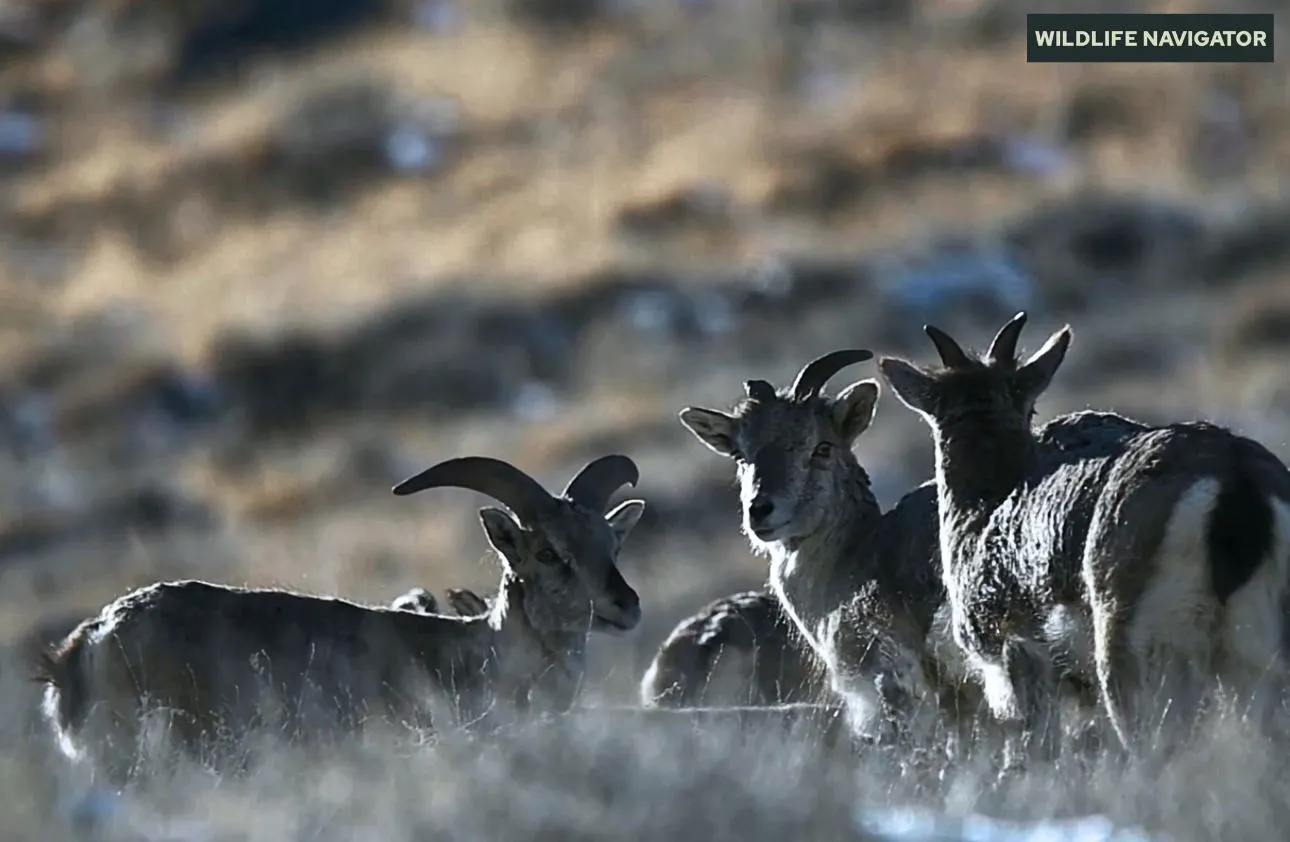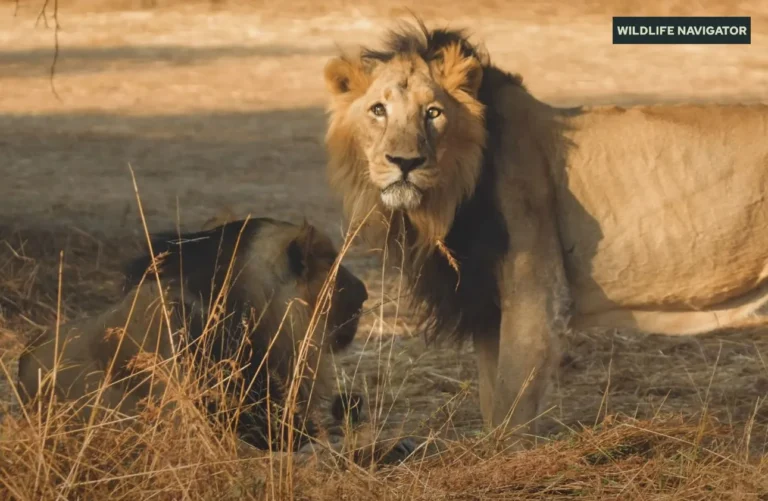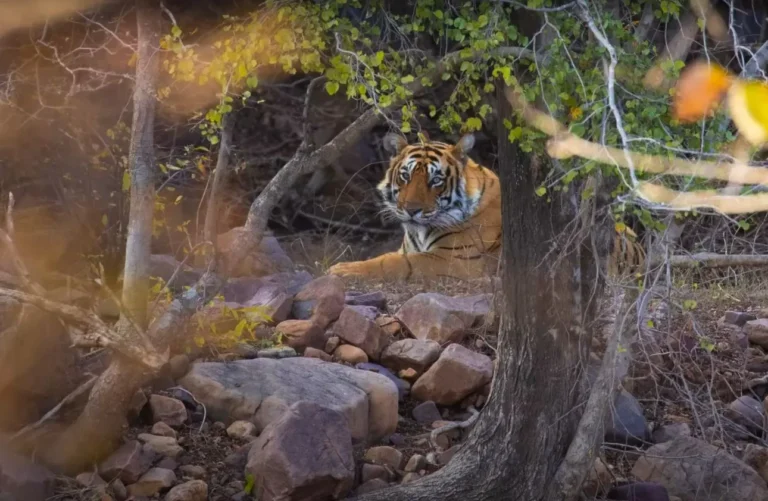Blue Sheep | Bharal – The Agile Himalayan Grazer

The Blue Sheep, also known as Bharal, is a fascinating and hardy herbivore found in the high-altitude regions of the Himalayas. Known for its striking bluish-grey coat and remarkable ability to navigate steep, rocky terrains, the Blue Sheep plays a crucial role in the Himalayan ecosystem. It serves as a primary prey species for apex predators like the snow leopard, making it essential for maintaining ecological balance.
In India, these mountain grazers are most commonly spotted in northern states like Ladakh, Himachal Pradesh, and Uttarakhand, where they thrive in cold, arid environments above 3,000 meters. Observing Bharal in the wild is a unique experience, offering wildlife enthusiasts a glimpse into the rugged life of Himalayan fauna.
This blog will take you through the appearance, behaviour, habitat, threats, and conservation of the Blue Sheep, along with tips on where to spot them in India’s national parks.
Scientific Classification
The Blue Sheep, commonly known as Bharal, is a unique herbivore native to the high-altitude regions of the Himalayas. Its scientific classification helps us understand its place in the animal kingdom and its relation to other species.
- Kingdom: Animalia – Like all animals, Blue Sheep are multicellular organisms that rely on consuming organic matter for sustenance.
- Phylum: Chordata – They belong to this phylum because they possess a notochord (a primitive backbone) at some stage of development.
- Class: Mammalia – As mammals, Bharal are warm-blooded, have fur, and females nurse their young with milk.
- Order: Artiodactyla – This order includes even-toed ungulates, meaning their weight is distributed equally on two main toes, which helps them navigate rocky mountain terrain.
- Family: Bovidae – The family of bovids includes antelopes, goats, and sheep. Blue Sheep are closely related to mountain goats and wild sheep.
- Genus: Pseudois – Bharal are the only members of this genus, making them quite unique.
- Species: Pseudois nayaur – This is the specific species name for the Blue Sheep.
Alternate Names:
- Bharal – widely used in India and Nepal
- Blue Sheep – reference to their bluish-grey coat, which camouflages them against rocky cliffs
Understanding their scientific classification highlights how Bharal are specially adapted for survival in harsh mountainous environments and how they fit into the broader ecosystem alongside other high-altitude herbivores and predators like snow leopards.
Physical Appearance
The Blue Sheep (Bharal) has a distinctive bluish-grey coat, which helps it blend seamlessly with the rocky Himalayan slopes. Males and females show subtle differences:
- Size & Weight:
- Males: 60–120 kg, slightly larger and bulkier
- Females: 35–60 kg
- Horns:
- Males have large, curved horns that can reach up to 70 cm, used for dominance battles during mating season
- Females have shorter, thinner horns
- Other Features:
- Stocky body, short legs with muscular build
- Light underbelly contrasting with darker back
- Strong hooves adapted for climbing steep, rocky surfaces
The Bharal’s colouration and horn structure not only aid survival in its harsh environment but also make it one of the most recognisable mountain ungulates in the Himalayas.
Habitat and Distribution
The Blue Sheep (Bharal) is a specialist of high-altitude mountainous regions. Its unique adaptations allow it to thrive where few other herbivores can survive.
- Geographic Range:
- India: Ladakh, Himachal Pradesh, Uttarakhand, Sikkim
- Neighbouring Countries: Nepal, Bhutan, Tibet (China)
- Altitude:
- Typically found between 3,000 to 5,500 meters above sea level
- Prefers steep, rocky slopes with sparse vegetation
- Terrain & Climate:
- Rocky cliffs, alpine meadows, and rugged ridges
- Cold, arid conditions with harsh winters and moderate summers
- Vegetation:
- Grazes on grasses, herbs, shrubs, and lichens that grow in high-altitude meadows
- Adapts to seasonal changes, moving to lower altitudes during heavy snow
The Bharal’s choice of habitat provides safety from most predators, while their agility on rocky slopes allows them to evade threats effectively. These high-altitude dwellers are a key part of the Himalayan ecosystem, supporting predator species like snow leopards.
Behaviour and Lifestyle
Blue Sheep (Bharal) are highly adapted to the harsh Himalayan environment, and their behaviour reflects their survival strategies in rugged, high-altitude terrains.
- Social Structure:
- Typically live in small herds of 10–30 individuals
- Herds are usually female-led, with males joining during mating season
- Young males may form bachelor groups before joining female herds
- Feeding Habits:
- Primarily grazers, feeding on grasses, herbs, mosses, and lichens
- Diet varies seasonally: during winter, they feed on hardy shrubs and sparse alpine plants
- Require frequent movement to find fresh grazing areas
- Daily Activity:
- Mostly diurnal, active during daylight for feeding and resting on rocky ledges
- Rest in sheltered areas during extreme weather conditions
- Adaptations:
- Strong, muscular legs and specialised hooves for climbing steep cliffs
- Camouflaged coat blends with rocky terrain for protection against predators
- Excellent eyesight to detect predators from a distance
- Communication:
- Use body posture and head movements for herd coordination
- Vocalisations are rare, mainly during alarm or mating
The Bharal’s social and behavioural patterns allow it to survive in extreme conditions, making it an essential prey species for apex predators like snow leopards, while maintaining the fragile balance of Himalayan ecosystems.
Breeding and Life Cycle
The Blue Sheep (Bharal) has a life cycle finely tuned to the seasonal rhythms of the high Himalayas.
- Mating Season:
- Occurs from November to January
- Dominant males engage in head-butting battles to secure mating rights
- Males establish temporary territories to attract females
- Gestation and Offspring:
- Gestation lasts approximately 5–6 months
- Females give birth to one or occasionally two lambs in late spring or early summer
- Lambs are born on steep, sheltered cliffs to avoid predators
- Growth and Development:
- Lambs are able to stand and move within hours of birth
- Remain close to their mothers for protection and feeding
- Weaned at around 3–4 months, gradually joining the herd for grazing
- Lifespan:
- Typically 10–12 years in the wild
- Maturity is reached at around 2–3 years
The timing of breeding ensures that offspring are born during periods of abundant food and milder weather, increasing survival chances. The species’ reproductive strategy is critical for maintaining population stability in harsh high-altitude habitats.
Predators and Threats
The Blue Sheep faces both natural predators and human-induced threats in its Himalayan habitat.
- Natural Predators:
- Snow Leopard: The primary predator, relying on Bharal as a major food source
- Wolves: Occasionally hunt in packs, targeting weaker or young individuals
- Golden Eagles & Other Birds of Prey: May prey on lambs
- Himalayan Lynx: Opportunistic predator where populations overlap
- Human-Induced Threats:
- Habitat Loss: Expansion of settlements, roads, and tourism in high-altitude areas
- Poaching: Occasionally hunted for meat, horns, or traditional medicine
- Competition with Livestock: Domestic grazing reduces available food resources
- Survival Strategies:
- Excellent camouflage and agility on rocky slopes help evade predators
- Herd behaviour allows vigilance and early detection of threats
Despite these strategies, human pressures combined with climate change pose significant challenges, emphasising the need for conservation efforts to protect these unique Himalayan grazers.
Conservation Status
The Blue Sheep (Bharal) is currently classified as “Least Concern” on the IUCN Red List, but its populations face localised pressures that require ongoing monitoring.
- Population Trends:
- Populations are generally stable in remote Himalayan regions
- Vulnerable in areas impacted by human activities or climate change
- Protected Areas in India:
- Hemis National Park, Ladakh
- Kibber Wildlife Sanctuary, Himachal Pradesh
- Pin Valley National Park, Himachal Pradesh
- Gangotri National Park, Uttarakhand
- Conservation Efforts:
- Legal protection under Indian wildlife laws
- Monitoring by park authorities to prevent poaching
- Community awareness programs to reduce human-wildlife conflict
- Research on habitat use, population dynamics, and predator-prey interactions
Although not currently endangered, the Blue Sheep’s dependence on fragile alpine ecosystems makes it sensitive to environmental changes. Continued conservation measures are essential to ensure the long-term survival of Bharal in the Himalayas.
Where to Spot Blue Sheep in India
The Blue Sheep inhabits the high-altitude regions of the Indian Himalayas, making sightings a special experience for wildlife enthusiasts and trekkers.
- Hemis National Park, Ladakh:
- One of the largest protected areas in India
- Bharal are commonly seen grazing on steep slopes alongside snow leopards
- Kibber Wildlife Sanctuary, Spiti Valley, Himachal Pradesh:
- Known for large herds in open alpine meadows
- The sanctuary provides excellent photography opportunities
- Pin Valley National Park, Himachal Pradesh:
- Semi-arid landscapes with rugged cliffs are perfect for Bharal habitat
- Spotting is easier during early morning or late afternoon
- Gangotri National Park, Uttarakhand:
- Bharal live in high-altitude meadows and rocky slopes
- Trekking routes often pass through areas frequented by herds
- Padmaja Naidu Himalayan Zoological Park, Darjeeling, West Bengal
- This high-altitude zoo specialises in breeding alpine species and has a successful program for the Blue Sheep.
- Himalayan Nature Park, Kufri, Himachal Pradesh
- Located near Shimla, this park has achieved successful breeding of Blue Sheep, contributing to conservation efforts.
- Gopalpur Zoo, Kangra District, Himachal Pradesh
- Nestled in the Dhauladhar Range, this zoo houses a variety of Himalayan species, including the Bharal.
International Zoos
- Moscow Zoo, Russia
- Home to a herd of Blue Sheep, the Moscow Zoo has been actively involved in breeding and conservation efforts for this species.
- Kaliningrad Zoo, Russia
- This zoo features Bharal in its exhibits, providing visitors with an opportunity to observe these elusive mountain grazers.
Seeing Bharal in their natural environment is a memorable wildlife experience, showcasing their incredible agility and the pristine beauty of the Himalayas.
Interesting Facts About Blue Sheep
- Exceptional Climbers: Bharal can navigate steep, rocky cliffs with incredible agility, often leaping between ledges to escape predators.
- Camouflage Experts: Their bluish-grey coat blends perfectly with the Himalayan rocks, making them almost invisible from a distance.
- Key Prey Species: They are the primary prey of snow leopards, playing a vital role in maintaining predator-prey balance in the high Himalayas.
- Seasonal Movements: Move to lower altitudes during heavy snow and return to higher meadows in summer for grazing.
- Minimal Vocalisation: They communicate mostly through body language, using posture and head movements within the herd.
- Cultural Significance: Locals in Ladakh and Himachal Pradesh consider Bharal an important part of Himalayan folklore, often symbolising agility and survival in harsh conditions.
- Adaptations to Cold: Thick fur, short tail, and muscular build help retain heat and navigate snow-covered slopes.
These facts highlight the uniqueness of Bharal, not just as a Himalayan grazer but as a symbol of resilience and adaptation in one of the world’s harshest environments.
Conclusion
The Blue Sheep is a remarkable inhabitant of the Himalayas, perfectly adapted to survive in extreme high-altitude environments. Its striking appearance, agility on rocky slopes, and role as prey for apex predators make it a vital part of the Himalayan ecosystem.
While currently classified as “Least Concern,” the Bharal’s survival depends on protected habitats and conservation efforts to mitigate threats from human activities and climate change. For wildlife enthusiasts and trekkers, spotting these mountain grazers offers a rare glimpse into the resilient life of Himalayan fauna.
By respecting their natural habitat and supporting conservation initiatives, we can ensure that the Blue Sheep continues to thrive in the majestic landscapes of the Himalayas for generations to come.





